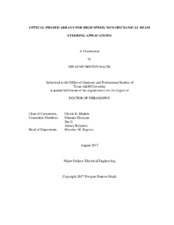| dc.contributor.advisor | Madsen, Christi K | |
| dc.creator | Macik, Dwayne Denton | |
| dc.date.accessioned | 2020-02-24T20:41:52Z | |
| dc.date.available | 2020-02-24T20:41:52Z | |
| dc.date.created | 2017-08 | |
| dc.date.issued | 2017-07-20 | |
| dc.date.submitted | August 2017 | |
| dc.identifier.uri | https://hdl.handle.net/1969.1/187231 | |
| dc.description.abstract | Optical beam steering has many applications ranging from sensing and detecting to light and image projection. A hybrid annealed proton exchange waveguide with a vertically integrated arsenic trisulfide waveguide on a lithium niobate substrate was used to create a low-loss, high-speed optical phased array that allows for the non-mechanical steering of 1550 nm light on an integrated optic platform. The high electro-optic coefficient of the x-cut y-propagating LiNbO₃ (r₃₃ = 30.8 pm/V) is utilized by electrode structures fabricated on the LiNbO3 substrate to create low-power, low-loss beam steering with high-speed bandwidths, capable of 10 GHz and larger, as demonstrated by commercial LiNbO₃ modulators. The introduction of the higher refractive index As₂S₃ waveguide is critical because it leads to a highly confined optical mode. The design, simulation, and fabrication of this device are presented here.
For measurements and as a preliminary proof of concept, two different platforms have been employed in series to leverage EO tuning. An APE:LiNbO₃ optical phased array was fabricated and edge coupled to a silicon nitride 8x8 waveguide array that condenses the output pitch and utilizes the Triplex™ waveguide technology. To characterize and tune this device, a 3 lens imaging system was utilized to produce both near- and far- field intensity patterns of the output of the OPA on a static image plane. At the image plane, a high resolution infrared camera was used to observe the resulting intensity pattern. The control software for tuning the OPA can read the intensity incident at a specified position on the detector array, and has an electronically controlled pulse width modulation hardware interface to drive the electro-optic phase shifters. Beam steering was achieved using an iterative tuning algorithm to maximize the intensity at a specified location. | en |
| dc.format.mimetype | application/pdf | |
| dc.language.iso | en | |
| dc.subject | Optical Phased Array | en |
| dc.subject | Non-mechanical beam steering | en |
| dc.subject | High Speed | en |
| dc.subject | Lithium Niobate | en |
| dc.subject | Arsenic Trisulfide | en |
| dc.subject | Annealed Proton Exchange | en |
| dc.subject | OPA | en |
| dc.subject | NMBS | en |
| dc.subject | LiNbO3 | en |
| dc.subject | As2S3 | en |
| dc.subject | APE | en |
| dc.title | Optical Phased Arrays for High Speed, Non-Mechanical Beam Steering Applications | en |
| dc.type | Thesis | en |
| thesis.degree.department | Electrical and Computer Engineering | en |
| thesis.degree.discipline | Electrical Engineering | en |
| thesis.degree.grantor | Texas A&M University | en |
| thesis.degree.name | Doctor of Philosophy | en |
| thesis.degree.level | Doctoral | en |
| dc.contributor.committeeMember | Eknoyan, Ohannes | |
| dc.contributor.committeeMember | Ji, Jim | |
| dc.contributor.committeeMember | Belyanin, Alexey | |
| dc.type.material | text | en |
| dc.date.updated | 2020-02-24T20:41:52Z | |
| local.etdauthor.orcid | 0000-0002-0122-1716 | |


